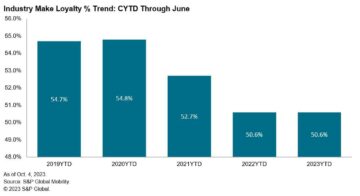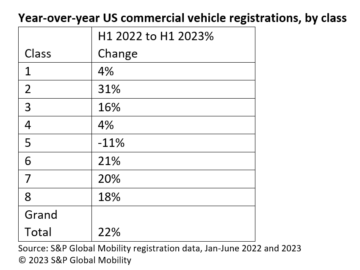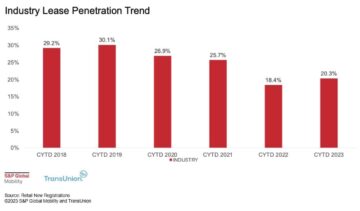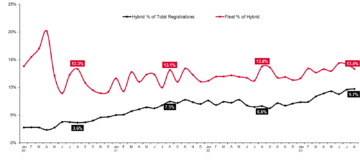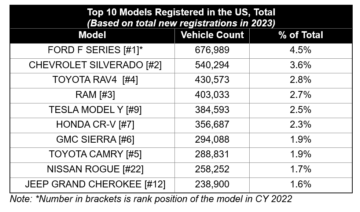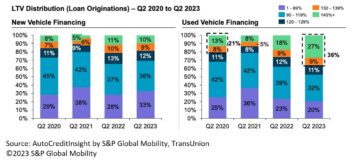Strong initial results trigger an
upgrade in S&P Global Mobility’s year-over-year forecast,
though economic and emissions headwinds remain.
Mainland China’s medium- and heavy-duty truck
production has surged strongly in early 2023, with double-digit
year-over-year growth seen in the February through April
period.
As a result, S&P Global Mobility has
increased its outlook for mainland China’s medium- and heavy-duty
truck production for 2023 by an additional 4 percentage points to
914,000 units, bringing the forecast year-over-year gain from 2022
to 26%.
The better-than-expected readings and low-base
effect are positive in supporting a solid near-term path to further
improvements in the truck manufacturing industry, but constraints
from both the demand and supply sides remain concerns.
The robust rebound was underpinned by the
broad-based recovery of the domestic economy following the
reopening from tough COVID restrictions and a continuous upturn in
truck exports that seemed to defy the challenging external economic
environment.
Speedy economic restoration unleashes
pent-up demand
Driven by the post-pandemic business resumption
and improved consumer confidence, household consumption, and
industrial output recovered at a fast clip entering 2023,
supporting the road freight sector to restart growth. This was seen
in the January through April period when the road freight tonnage –
which supports nearly 75% of domestic freight transport – rose by
8% from a year earlier.
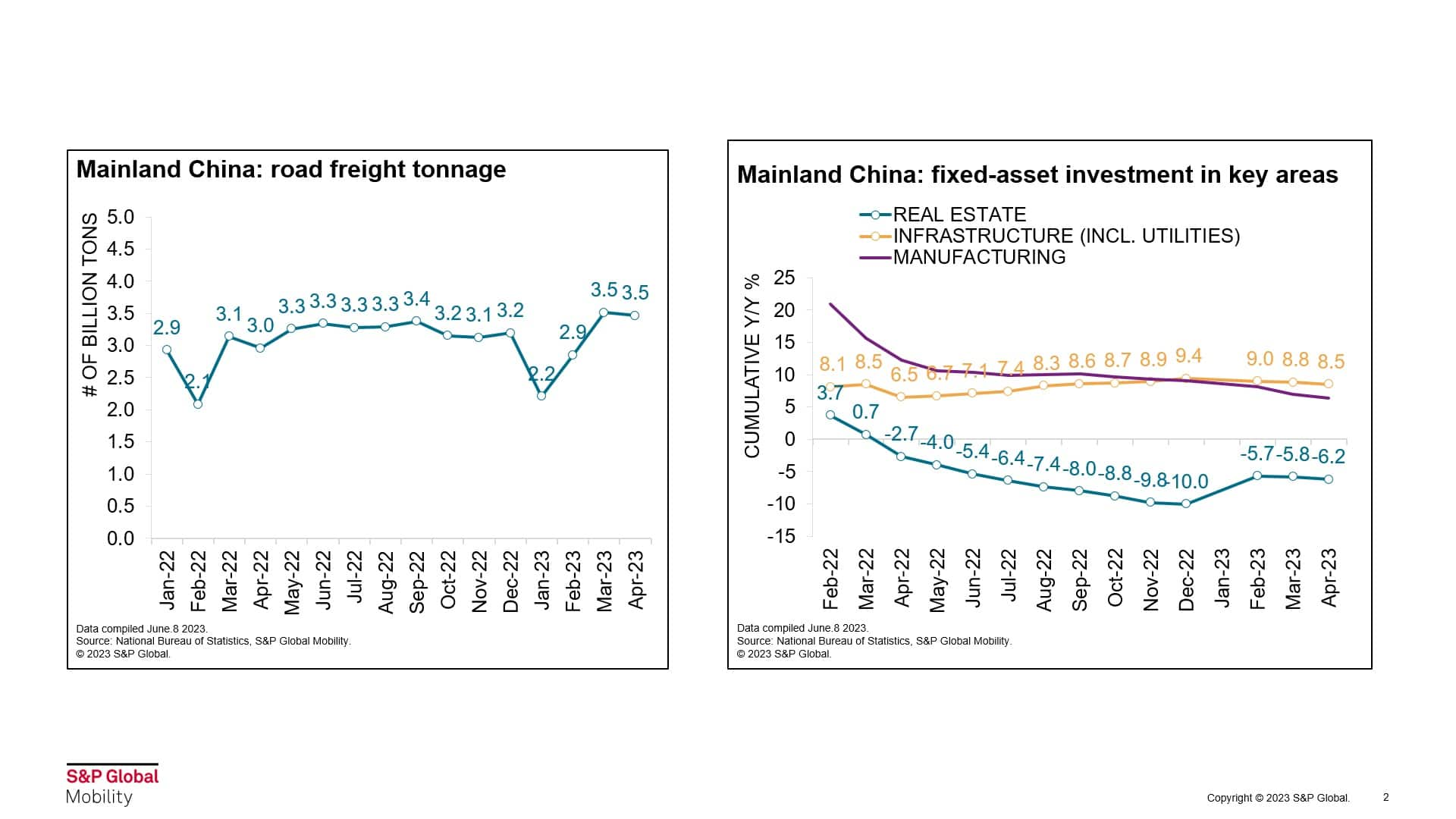
At the same time, fiscal policies have remained
accommodative. Specifically, the local government special-purpose
bond quota, the main source of infrastructure investment, is set at
3.8 trillion yuan (approximately US$530 billion) for 2023 – higher
than the originally planned quota of 3.65 trillion yuan for 2022.
By the end of February 2023, more than 60% of the local government
special-purpose bonds had been pre-launched – compared with around
30% in the same period of 2022.
Under this frontloaded stimulus, infrastructure
investment (excluding utilities) expanded by 8.5% year-over-year
through April. Also, the property market started to show signs of a
restoration amid the ramp-up of bailout packages such as
mortgage-rate reductions, easing credit conditions for developers,
and loosening purchase restrictions for buyers.

With these circumstances, production of
tractor-trailer and construction trucks had a combined market share
of 60% in 2022 and surged by 50% year-over-year in the first four
months of 2023. Riding on this trend, S&P Global Mobility added
10,000 units to the May production forecast.
Booming exports provide a boost to
production
Mainland China’s medium- and heavy-truck
exports have entered a fast track since 2021 when pandemic-led
supply chain disruptions crimped overseas manufacturing activities.
With truck makers stepping up efforts in global expansion to
counter the domestic industry downturn, exports from Mainland China
have extended their rally into 2023 – increasing 57% to 97,000
units through April.
The headline growth was led by heavy
tractor-trailers, which more than doubled in export volumes from a
year ago. Supported by the government’s Belt and Road initiatives,
Southeast Asia, the Middle East, Africa, and South America have
remained core export destinations – with market share staying above
70% of total exports over the years.
In addition, exports to Russia and Mexico
became new bright spots in recent years. The exodus of Western
automakers from Russia since early 2022, in response to the
invasion of Ukraine, allowed Chinese brands to seize market share
in the Russian MHCV market. In the first four months of 2023,
exports to Russia continued explosive growth and amounted to 34,000
units, a level close to the entire 2022 total. The year-to-date
share of Chinese brands in the market has grown to nearly 60%.
Meanwhile, exports to Mexico recorded a
double-digit increase under the growing local demand for
construction trucks. In the coming months, the run rate of MHCV
exports is expected to hold steady, driving up the production
forecast by 20,000 units compared to our outlook released in
February.
Economic and emissions headwinds
remain
A potential future upgrade of our production
outlook is under assessment, with the domestic economic resurgence
building momentum. However, reaching the peak level of 2020 is
unlikely, as structural unemployment and still-tepid household
income prospects could blunt pro-growth measures’ ability to fully
materialize. Meanwhile, aggressive economic stimulus policies could
be restrained by the government’s fiscal de-risking, as well as
budget scarcity.
On the emissions front, although more cities
doubled down on the fight to remove CN4-compliant trucks from roads
starting in 2023, many areas lacked specific targets and subsidy
plans – curbing the effect of policies. In addition, despite the
healthy recovery of road freight transport, freight rates have
remained in depression, reflecting an oversupply of trucking. These
factors may lead truckers and fleet operators to postpone purchase
decisions or shift towards used trucks for cost-saving
purposes.
CHINA TO BECOME #1
LIGHT-VEHICLE EXPORTER THIS YEAR
CAN BRAZIL’S COMMERCIAL
TRUCK FLEET TURN ELECTRIC?
MHCV ALTERNATIVE
PROPULSION FORECAST
This article was published by S&P Global Mobility and not by S&P Global Ratings, which is a separately managed division of S&P Global.
- SEO Powered Content & PR Distribution. Get Amplified Today.
- PlatoData.Network Vertical Generative Ai. Empower Yourself. Access Here.
- PlatoAiStream. Web3 Intelligence. Knowledge Amplified. Access Here.
- PlatoESG. Automotive / EVs, Carbon, CleanTech, Energy, Environment, Solar, Waste Management. Access Here.
- BlockOffsets. Modernizing Environmental Offset Ownership. Access Here.
- Source: http://www.spglobal.com/mobility/en/research-analysis/mainland-china-commercial-truck-production-starts-2023-with-a-.html
- :has
- :is
- :not
- ][p
- $UP
- 000
- 10
- 20
- 2020
- 2021
- 2022
- 2023
- 65
- 8
- a
- ability
- above
- activities
- added
- addition
- Additional
- africa
- aggressive
- ago
- allowed
- also
- alternative
- Although
- america
- Amid
- an
- and
- approximately
- April
- ARE
- areas
- around
- article
- AS
- asia
- assessment
- At
- automakers
- bailout
- BE
- became
- become
- been
- Billion
- bond
- Bonds
- boost
- both
- brands
- Brazil
- Bright
- Bringing
- broad-based
- budget
- Building
- business
- but
- buyers
- by
- Capacity
- chain
- challenging
- China
- chinese
- circumstances
- Cities
- Close
- combined
- coming
- commercial
- compared
- Concerns
- conditions
- confidence
- constraints
- construction
- consumer
- consumption
- continued
- continuous
- Core
- could
- Counter
- Covid
- credit
- decisions
- Demand
- depression
- Despite
- destinations
- developers
- disruptions
- Division
- Domestic
- doubled
- down
- DOWNTURN
- driving
- Earlier
- Early
- easing
- East
- Economic
- economy
- effect
- efforts
- Electric
- Emissions
- end
- entered
- entering
- Entire
- Environment
- excluding
- Exodus
- expanded
- expansion
- expected
- export
- exports
- external
- factors
- FAST
- February
- fight
- First
- Fiscal
- FLEET
- following
- For
- Forecast
- four
- freight
- from
- front
- fully
- further
- future
- Gain
- Global
- global expansion
- Government
- Growing
- grown
- Growth
- had
- Have
- headline
- headwinds
- healthy
- heavy
- heavy-duty
- higher
- hold
- household
- However
- HTML
- HTTPS
- improved
- improvements
- in
- Income
- Increase
- increased
- increasing
- industrial
- industry
- Infrastructure
- initial
- initiatives
- into
- invasion
- investment
- ITS
- January
- jpg
- lead
- Led
- Level
- local
- Local Government
- Main
- mainland
- mainland china
- Makers
- managed
- manufacturing
- manufacturing industry
- many
- Market
- May..
- Meanwhile
- measures
- Mexico
- Middle
- Middle East
- mobility
- Momentum
- months
- more
- nearly
- New
- of
- on
- operators
- or
- originally
- our
- Outlook
- output
- over
- overseas
- packages
- path
- Peak
- percentage
- period
- planned
- plans
- plato
- Plato Data Intelligence
- PlatoData
- points
- policies
- positive
- post-pandemic
- potential
- powerful
- Production
- property
- propulsion
- prospects
- provide
- published
- purchase
- purposes
- rally
- Rate
- Rates
- ratings
- reaching
- rebound
- recent
- recorded
- recovery
- reductions
- released
- remain
- remained
- remove
- response
- restoration
- restrictions
- result
- Results
- riding
- road
- roads
- robust
- ROSE
- Run
- Russia
- russian
- s
- S&P
- S&P Global
- same
- Scarcity
- sector
- seemed
- seen
- Seize
- separately
- set
- Share
- shift
- show
- Sides
- Signs
- since
- solid
- Source
- South
- South America
- Southeast Asia
- specific
- specifically
- started
- Starting
- starts
- steady
- stepping
- stimulus
- strongly
- structural
- subsidy
- such
- supply
- supply chain
- Supported
- Supporting
- Supports
- Surged
- targets
- than
- that
- The
- their
- These
- this
- though?
- Through
- time
- to
- Total
- tough
- towards
- track
- transport
- Trend
- trigger
- Trillion
- truck
- Trucking
- Trucks
- TURN
- Ukraine
- under
- underpinned
- unemployment
- units
- unleashes
- unlikely
- upgrade
- used
- utilities
- volumes
- was
- WELL
- Western
- when
- which
- with
- XML
- year
- years
- Yuan
- zephyrnet

